7-Methoxytacrine
General
Type : Derivative of Tacrine,Acridine
Chemical_Nomenclature : 7-methoxy tetrahydroamino-acridine\; 7-methoxy 1,2,3,4,-tetrahydro-9 aminoacridine
Canonical SMILES : COC1=CC2=C(C=C1)N=C3CCCCC3=C2N
InChI : InChI=1S\/C14H16N2O\/c1-17-9-6-7-13-11(8-9)14(15)10-4-2-3-5-12(10)16-13\/h6-8H,2-5H2,1H3,(H2,15,16)
InChIKey : APQPVVOYBLOJDY-UHFFFAOYSA-N
Other name(s) : 7-Meota,CHEMBL1256415,TA-03,BRN 0477401,1,2,3,4-Tetrahydro-7-methoxy-9-acridinamine,9-Amino-7-methoxy-1,2,3,4-tetrahydroacridine,5-22-12-00199,Acridine, 1,2,3,4-tetrahydro-9-amino-7-methoxy-,9-Acridinamine, 1,2,3,4-tetrahydro-7-methoxy- (9CI),7-MTHA,7-methoxy tetrahydroamino-acridine
MW : 228.29
Formula : C14H16N2O
CAS_number :
PubChem : 119053
UniChem : APQPVVOYBLOJDY-UHFFFAOYSA-N
IUPHAR :
Wikipedia :

Target
References (15)
| Title : A Resurrection of 7-MEOTA: A Comparison with Tacrine - Soukup_2013_Curr.Alzheimer.Res_10_893 |
| Author(s) : Soukup O , Jun D , Karasova JZ , Patocka J , Musilek K , Korabecny J , Krusek J , Kaniakova M , Sepsova V , Mandikova J , Trejtnar F , Pohanka M , Drtinova L , Pavlik M , Tobin G , Kuca K |
| Ref : Curr Alzheimer Res , 10 :893 , 2013 |
| Abstract : Soukup_2013_Curr.Alzheimer.Res_10_893 |
| ESTHER : Soukup_2013_Curr.Alzheimer.Res_10_893 |
| PubMedSearch : Soukup_2013_Curr.Alzheimer.Res_10_893 |
| PubMedID: 24093535 |
| Title : Antiacetylcholinesterase activity of cyclosporine--a comparison of single and repeated administration and effect of 7-methoxytacrine - Herink_2002_Acta.Medica.(Hradec.Kralove)_45_145 |
| Author(s) : Herink J , Krejcova G , Bajgar J |
| Ref : Acta Medica (Hradec Kralove) , 45 :145 , 2002 |
| Abstract : Herink_2002_Acta.Medica.(Hradec.Kralove)_45_145 |
| ESTHER : Herink_2002_Acta.Medica.(Hradec.Kralove)_45_145 |
| PubMedSearch : Herink_2002_Acta.Medica.(Hradec.Kralove)_45_145 |
| PubMedID: 12587781 |
| Title : Effect of 7-methoxytacrine and L-carnitine on the activity of choline acetyltransferase - Bajgar_1999_Gen.Physiol.Biophys_18 Spec No_3 |
| Author(s) : Bajgar J , Skopec F , Herink J , Patocka J , Kvetina J |
| Ref : Gen Physiol Biophys , 18 Spec No :3 , 1999 |
| Abstract : Bajgar_1999_Gen.Physiol.Biophys_18 Spec No_3 |
| ESTHER : Bajgar_1999_Gen.Physiol.Biophys_18 Spec No_3 |
| PubMedSearch : Bajgar_1999_Gen.Physiol.Biophys_18 Spec No_3 |
| PubMedID: 10703712 |
| Title : Capillary zone electrophoretic determination of some drugs against Alzheimer's disease - Vargas_1998_J.Chromatogr.A_802_121 |
| Author(s) : Vargas MG , Havel J , Patocka J |
| Ref : Journal of Chromatography A , 802 :121 , 1998 |
| Abstract : Vargas_1998_J.Chromatogr.A_802_121 |
| ESTHER : Vargas_1998_J.Chromatogr.A_802_121 |
| PubMedSearch : Vargas_1998_J.Chromatogr.A_802_121 |
| PubMedID: 9588015 |
| Title : Differential inhibition of rat brain acetylcholinesterase molecular forms by 7-methoxytacrine in vitro - Bajgar_1995_Toxicol.Lett_80_109 |
| Author(s) : Bajgar J , Bisso GM , Michalek H |
| Ref : Toxicology Letters , 80 :109 , 1995 |
| Abstract : Bajgar_1995_Toxicol.Lett_80_109 |
| ESTHER : Bajgar_1995_Toxicol.Lett_80_109 |
| PubMedSearch : Bajgar_1995_Toxicol.Lett_80_109 |
| PubMedID: 7482577 |
| Title : [Treatment of tardive dyskinesias with 7-methoxytacrine. I] - Hanus_1993_Sb.Ved.Pr.Lek.Fak.Karlovy.Univerzity.Hradci.Kralove.Suppl_36_37 |
| Author(s) : Hanus H , Tuma I , Fusek J , Patocka J |
| Ref : Sb Ved Pr Lek Fak Karlovy Univerzity Hradci Kralove Suppl , 36 :37 , 1993 |
| Abstract : Hanus_1993_Sb.Ved.Pr.Lek.Fak.Karlovy.Univerzity.Hradci.Kralove.Suppl_36_37 |
| ESTHER : Hanus_1993_Sb.Ved.Pr.Lek.Fak.Karlovy.Univerzity.Hradci.Kralove.Suppl_36_37 |
| PubMedSearch : Hanus_1993_Sb.Ved.Pr.Lek.Fak.Karlovy.Univerzity.Hradci.Kralove.Suppl_36_37 |
| PubMedID: 8191251 |
| Title : Pharmacokinetics and tolerance of 7-methoxytacrine following the single dose administration in healthy volunteers - Filip_1991_Int.J.Clin.Pharmacol.Ther.Toxicol_29_431 |
| Author(s) : Filip V , Vachek J , Albrecht V , Dvorak I , Dvorakova J , Fusek J , Havluj J |
| Ref : Int J Clinical Pharmacology & Therapeutics Toxicol , 29 :431 , 1991 |
| Abstract : Filip_1991_Int.J.Clin.Pharmacol.Ther.Toxicol_29_431 |
| ESTHER : Filip_1991_Int.J.Clin.Pharmacol.Ther.Toxicol_29_431 |
| PubMedSearch : Filip_1991_Int.J.Clin.Pharmacol.Ther.Toxicol_29_431 |
| PubMedID: 1800389 |
| Title : The binding of cholinesterase inhibitors tacrine (tetrahydroaminoacridine) and 7-methoxytacrine to muscarinic acetylcholine receptors in rat brain in the presence of eserine - Musilkova_1991_Neurosci.Lett_125_113 |
| Author(s) : Musilkova J , Tucek S |
| Ref : Neuroscience Letters , 125 :113 , 1991 |
| Abstract : Musilkova_1991_Neurosci.Lett_125_113 |
| ESTHER : Musilkova_1991_Neurosci.Lett_125_113 |
| PubMedSearch : Musilkova_1991_Neurosci.Lett_125_113 |
| PubMedID: 1881587 |
| Title : Negative effects of tacrine (tetrahydroaminoacridine) and methoxytacrine on the metabolism of acetylcholine in brain slices incubated under conditions stimulating neurotransmitter release - Tucek_1991_J.Neurochem_56_1216 |
| Author(s) : Tucek S , Dolezal V |
| Ref : Journal of Neurochemistry , 56 :1216 , 1991 |
| Abstract : Tucek_1991_J.Neurochem_56_1216 |
| ESTHER : Tucek_1991_J.Neurochem_56_1216 |
| PubMedSearch : Tucek_1991_J.Neurochem_56_1216 |
| PubMedID: 1672143 |
| Title : Positive and negative effects of tacrine (tetrahydroaminoacridine) and methoxytacrine on the metabolism of acetylcholine in brain cortical prisms incubated under resting conditions - Dolezal_1991_J.Neurochem_56_1207 |
| Author(s) : Dolezal V , Tucek S |
| Ref : Journal of Neurochemistry , 56 :1207 , 1991 |
| Abstract : Dolezal_1991_J.Neurochem_56_1207 |
| ESTHER : Dolezal_1991_J.Neurochem_56_1207 |
| PubMedSearch : Dolezal_1991_J.Neurochem_56_1207 |
| PubMedID: 2002337 |
| Title : Unexpected potentializing effect of a tacrine derivative (9-amino-7-methoxy-1,2,3,4 tetrahydroacridine) upon the non-epileptic myoclonus in baboons Papio papio - Svejdova_1990_Prog.Neuropsychopharmacol.Biol.Psychiatry_14_961 |
| Author(s) : Svejdova M , Rektor I , Silva-Barrat C , Menini C |
| Ref : Prog Neuropsychopharmacol Biological Psychiatry , 14 :961 , 1990 |
| Abstract : Svejdova_1990_Prog.Neuropsychopharmacol.Biol.Psychiatry_14_961 |
| ESTHER : Svejdova_1990_Prog.Neuropsychopharmacol.Biol.Psychiatry_14_961 |
| PubMedSearch : Svejdova_1990_Prog.Neuropsychopharmacol.Biol.Psychiatry_14_961 |
| PubMedID: 2126145 |
| Title : First experience with the application of 7-methoxytacrine to psychiatric patients - |
| Author(s) : Zapletalek M , Hanus H , Fusek J , Hrdina V |
| Ref : Activitas Nervosa Superior (Praha) , 31 :305 , 1989 |
| PubMedID: 2576923 |
| Title : Protective effect of 9-amino-7-methoxy-1,2,3,4-tetra-hydroacridine against inhibition of acetylcholinesterase by O-ethyl s-(2- dimethylaminoethyl) methylphosphonotioate in vivo - |
| Author(s) : Bajgar J , Fusek J , Patocka J , Hrdina V |
| Ref : Archives of Toxicology , 54 :163 , 1983 |
| PubMedID: 6651529 |
| Title : In vivo kinetics of blood cholinesterase inhibition by 9-amino-1, 2, 3, 4-tetrahydroacridine, its 7-methoxy derivative and physostigmine in rats - Bajgar_1979_Physiol.Bohemoslov_28_31 |
| Author(s) : Bajgar J , Fusek J , Patocka J , Hrdina V |
| Ref : Physiol Bohemoslov , 28 :31 , 1979 |
| Abstract : Bajgar_1979_Physiol.Bohemoslov_28_31 |
| ESTHER : Bajgar_1979_Physiol.Bohemoslov_28_31 |
| PubMedSearch : Bajgar_1979_Physiol.Bohemoslov_28_31 |
| PubMedID: 155828 |